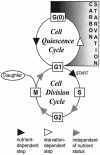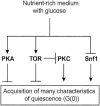"Sleeping beauty": quiescence in Saccharomyces cerevisiae
- PMID: 15187181
- PMCID: PMC419917
- DOI: 10.1128/MMBR.68.2.187-206.2004
"Sleeping beauty": quiescence in Saccharomyces cerevisiae
Abstract
The cells of organisms as diverse as bacteria and humans can enter stable, nonproliferating quiescent states. Quiescent cells of eukaryotic and prokaryotic microorganisms can survive for long periods without nutrients. This alternative state of cells is still poorly understood, yet much benefit is to be gained by understanding it both scientifically and with reference to human health. Here, we review our knowledge of one "model" quiescent cell population, in cultures of yeast grown to stationary phase in rich media. We outline the importance of understanding quiescence, summarize the properties of quiescent yeast cells, and clarify some definitions of the state. We propose that the processes by which a cell enters into, maintains viability in, and exits from quiescence are best viewed as an environmentally triggered cycle: the cell quiescence cycle. We synthesize what is known about the mechanisms by which yeast cells enter into quiescence, including the possible roles of the protein kinase A, TOR, protein kinase C, and Snf1p pathways. We also discuss selected mechanisms by which quiescent cells maintain viability, including metabolism, protein modification, and redox homeostasis. Finally, we outline what is known about the process by which cells exit from quiescence when nutrients again become available.
Figures




References
-
- Ashrafi, K., T. A. Farazi, and J. I. Gordon. 1998. A role for Saccharomyces cerevisiae fatty acid activation protein 4 in regulating protein N-myristoylation during entry into stationary phase. J. Biol. Chem. 273:25864-25874. - PubMed
-
- Beck, T., and M. N. Hall. 1999. The TOR signalling pathway controls nuclear localization of nutrient-regulated transcription factors. Nature 402:689-692. - PubMed
-
- Benaroudj, N., D. H. Lee, and A. L. Goldberg. 2001. Trehalose accumulation during cellular stress protects cells and cellular proteins from damage by oxygen radicals. J. Biol. Chem. 276:24261-24267. - PubMed
Publication types
MeSH terms
Substances
Grants and funding
LinkOut - more resources
Full Text Sources
Other Literature Sources
Molecular Biology Databases

